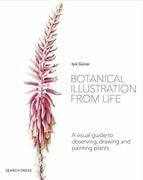
Leucocyclus Formosus Illustration
Extract from Botanical Illustration from Life • By Isik Guner • Published by Search PressAbout
Botanical Illustration from Life
Tags
© 2024 Isik Guner / Search Press · Reproduced with permission.
-
 Key West Witch favorited Leucocyclus Formosus Illustration
28 Jun 18:37
Key West Witch favorited Leucocyclus Formosus Illustration
28 Jun 18:37
-
 Sirena G. favorited Leucocyclus Formosus Illustration
09 Feb 10:31
Sirena G. favorited Leucocyclus Formosus Illustration
09 Feb 10:31
-
 Crafterella featured Leucocyclus Formosus Illustration
08 Feb 23:00
Crafterella featured Leucocyclus Formosus Illustration
08 Feb 23:00
-
 Jack Benjamin favorited Leucocyclus Formosus Illustration
08 Feb 12:32
Jack Benjamin favorited Leucocyclus Formosus Illustration
08 Feb 12:32
-
 campaspe favorited Leucocyclus Formosus Illustration
07 Feb 14:56
campaspe favorited Leucocyclus Formosus Illustration
07 Feb 14:56
-
 Search Press published her project Leucocyclus Formosus Illustration
07 Feb 09:48
Search Press published her project Leucocyclus Formosus Illustration
07 Feb 09:48
You Will Need
-
Step 5
Make your greys
If you mix any three main colours: reds, yellows and blues, in the correct amount, you will get grey. Explore mixing different main colours and you will be amazed to see the variety of tones and colours of grey you can obtain. The key point here is to use a lot of water for mixing and only a tiny bit of each pigment must be blended together. If you use a lot of pigment to start with, the mix will turn to a dirty brown colour.Mix of Cobalt Violet, Naples Yellow and Indigo.
Mix of Indigo, Cadmium Lemon, Scarlet Lake. -
 Step 6
Step 6Use the white of the paper
Apply the grey mix very gently. Ligulate flowers have a very small surface area, so use less water for the base. For white flowers, the key point is to keep the white of the paper unpainted. A grey colour must be applied only for the shadow areas. If it is all over the surface, the flower will look grey, not white. -
 Step 7
Step 7Increase the tone
Increase the tone of the shadow gently, in many layers. Look carefully at the overall flower to understand the light and shadow. The left side of the flower is more in shadow than the right. Keep using diluted pigments to build up the layers. Define each flower clearly, make sharp edges with denser pigments and apply the pigment on a dry surface for very fine details. Outlines for the edges can be very helpful to make the white flowers visible on the white surface. -
 Step 8
Step 8Sharpen the image
Shadow around the centre is important to give depth to the image. Always look for and understand where the darkest and the lightest areas are. A correct application of light and shade is the only way to create a three-dimensional image. The number of lines on each ligulate flower can be species specific. They must be observed very well from tip to base. Use different tones of grey for different layers or areas to get a better colour match and a more realistic image.









